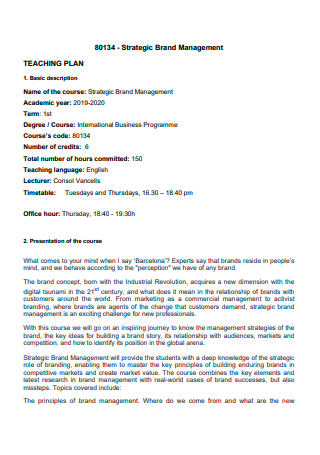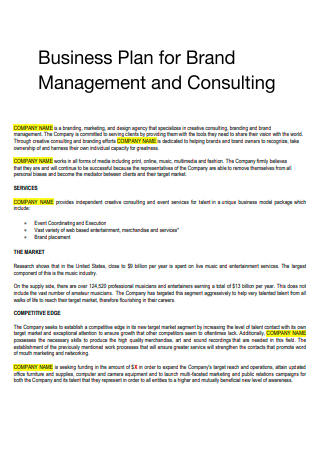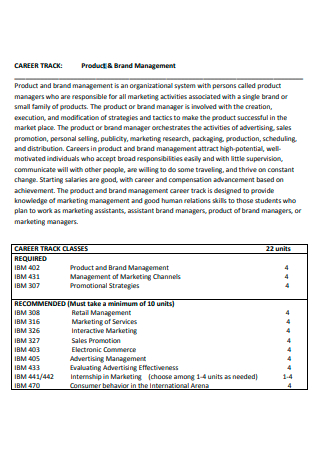3+ Sample Brand Management Plan
FREE Brand Management Plan s to Download
3+ Sample Brand Management Plan
What Is a Brand Management Plan?
How Brand Management Works
Effective Principles of Brand Management
Growth Strategies for Brands
How to Write a Brand Management Plan
FAQs
What are the requirements of a brand manager?
How are brands managed successfully?
What are tips for online brand management?
What Is a Brand Management Plan?
According to Investopedia, brand management is a marketing function that employs tactics to boost a product line’s or brand’s perceived value over time. Through favorable brand associations, imagery, and strong brand recognition, effective brand management allows product prices to grow while also maintaining loyal customers. When designing a strategic strategy to maintain or improve brand value, a full understanding of the brand, its target market, and the company’s overarching vision is essential. The brand management plan definition is that it acts as a strategic marketing process so that the public would still find it interesting and valuable despite the years passing by.
How Brand Management Works
Customer engagement, market competition, and corporate management are all influenced by brands. A strong brand presence in the market separates a company’s products from those of its competitors and fosters brand loyalty for its goods or services. A well-known brand must constantly manage its image in order to sustain its reputation. Effective brand management raises brand awareness, analyzes and manages brand equity, drives efforts that promote a consistent brand message, recognizes and integrates new brand products, and places the brand effectively in the market.
Effective Principles of Brand Management
To reiterate, brand management is the sum of all efforts that go into making a brand attractive, appealing, differentiated, successful, and ultimately profitable. When it comes to a brand as a whole, whether it’s a product or a service, what important is a focus on quality and delivery, continuous improvement strategies to maintain the same, marketing and messaging to communicate the brand’s value, and innovation to stay relevant in changing times. Before proceeding to write a brand management plan, first, go through this list of effective principles that are considered important to brand management.
Growth Strategies for Brands
For organizations wishing to expand their service or product offerings, here are classic brand growth tactics. These are the commonly used brand strategies to ensure the growth of the said brand. You don’t have to follow it and can use your own ideas and thought-up strategies. But still, thoroughly read this list as it may contribute to your ideas.
How to Write a Brand Management Plan
Now that you have gone through the contents of this article, you are more than ready to write your brand management marketing plan. Since it does function as a strategic brand management plan, you will need to write each step carefully and precisely. Your worries are lessened because this article provides you with templates and examples which save you time rather than starting from scratch. Proceed to check out the readily available brand management plan example and go through each step meticulously so you won’t forget any relevant details.
Step 1: State your Objectives
As part of the marketing situation, it will be necessary to define your objectives in the first place. This refers to the point that you are raising while thinking over the contents of the brand management plan. It is most important to be direct and concise in this part. Avoid getting carried away and only write what is necessary. The shorter, the better. Only talk about what is your central objective, though you may elaborate on how you reached that point.
Sep 2: Add your Strategy
For the next step, you will need to showcase your strategic planning process. After mentioning your objectives, you must be able to accurately represent your strategy to reinforce the brand. As part of your brand management plan, you will need to display what you have in store for the brand. This goes without saying that you can describe where you plan the brand to be headed and how are you able to execute the said plan. Proceed to the next step for more detailed elaboration.
Step 3: Create an Action Plan
An action plan is a series of steps that must be followed in order to complete a small project or achieve a specific objective. To make one, simply list the tasks that must be completed to fulfill your project or target in the sequence in which they must be completed. This step will require you to create an action plan so that readers of the brand management plan are able to understand and comprehensively identify your ideas. It may seem intimidating but you don’t have to worry because templates are available for you to use.
Step 4: Introduce your Team
You aren’t working alone, although you may be tasked to come up with the brand management plan, you still have other people who will work alongside you to execute the contents of the plan, if they are approved. Dedicate a section where you will be introducing the people who will be working closely with you to bring this plan to life. Make sure to label their roles so that readers will be aware of what they are contributing to the brand management plan.
Step 5: Clarify the Budget
As for the final step, you will need to set up a budget plan to accompany the brand management plan. Nothing is free after all, not the advertisements, the write-ups from journalists, and is presented through media. Higher-ups will appreciate you estimating the necessary budget to be spent on the brand management plan. It is worth mentioning that you have to set a budget that isn’t too much or too little because it could be the difference between being rejected or having your plan approved.
FAQs
What are the requirements of a brand manager?
A brand manager is in charge of the brand’s tangible and intangible properties. The price of a product, packaging, logo, accompanying colors, and text format are all physical characteristics of a company’s brand. The function of a brand manager is to examine how a brand is viewed in the market while taking into account the intangible aspects of the brand. Consumer experience with the brand and their emotional connection to the product or service are examples of intangible elements. Brand equity will increase in value if people are prepared to pay more for a brand than a generic brand that performs the same activities.
How are brands managed successfully?
The key to successful brand management is to create a positive and memorable brand experience for your customers through the various touchpoints you and your company have with them. Analysis of social media, subscriptions, database volume, and sales are all used to assess its efficacy. When you manage a brand, it isn’t solely for the company’s sake. You have to thoroughly think about the target audience and how they will be perceiving it as well. Being aware of the target market will help you to manage your brand in a way that will be much more effective and well-received.
What are tips for online brand management?
Online brand management must be a top priority since it has far-reaching business ramifications that directly affect your company’s success or failure, and it can be crucial when potential customers make purchasing decisions. It involves tracking and directing how your business is seen online. It covers all aspects of public perception, including websites, social media, third-party articles, online reviews, search engine results, and pretty much everywhere else you may discover online discussions. Since there are so many variables at play, managing your online brand is crucial. You can leave a positive lasting impression and boost brand growth and client reach by managing your online brand.
Think of it as a brand management business plan, like any other company, they don’t merely whip up a brand without careful consideration of how it could affect the company. A company that is aware of what its target audience wants is more successful than a company that does not bother with the comments of the market. With that being said, you are more than ready to proceed to write a brand management plan!




